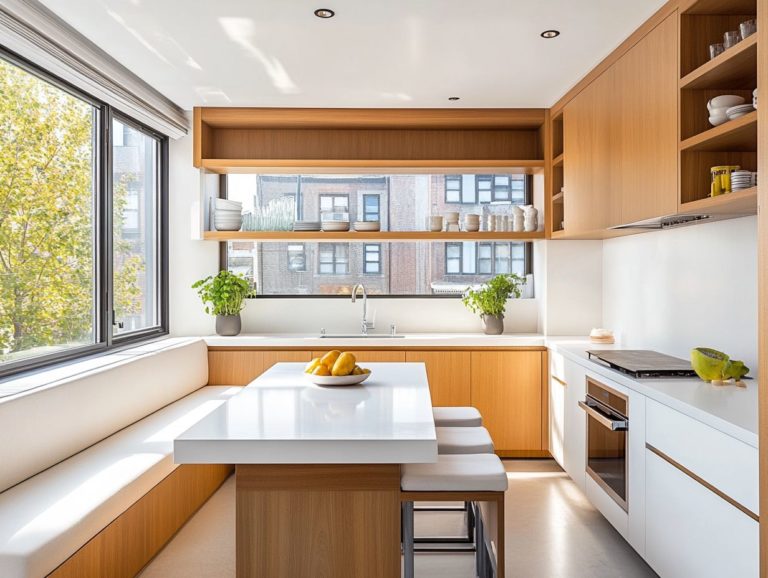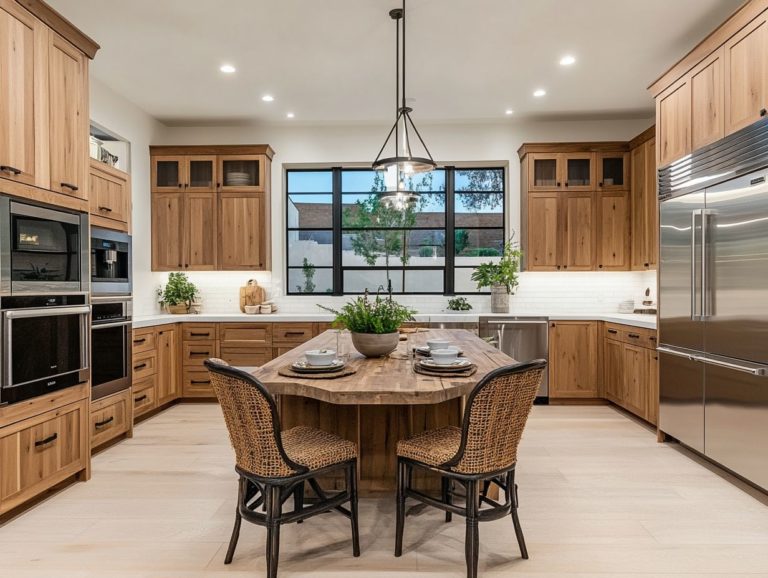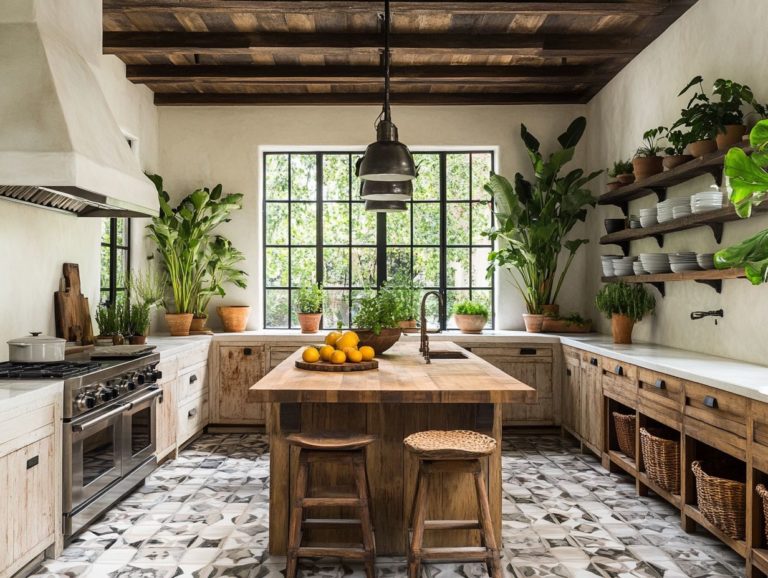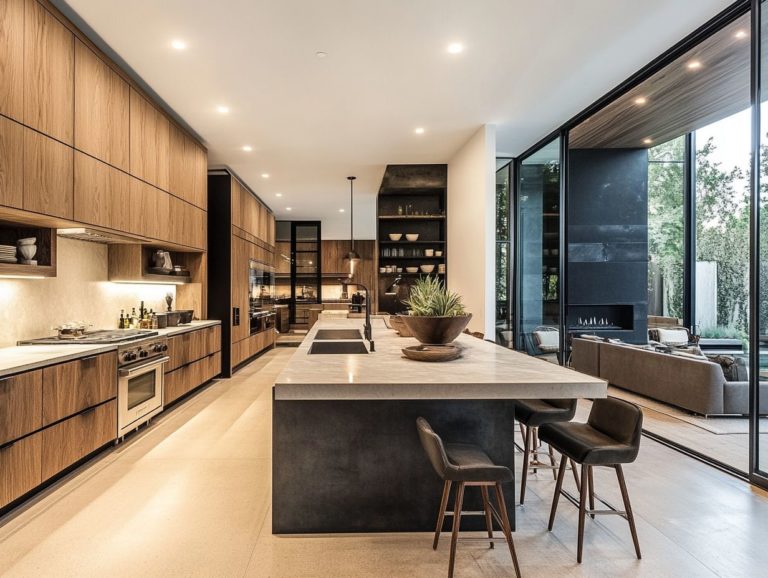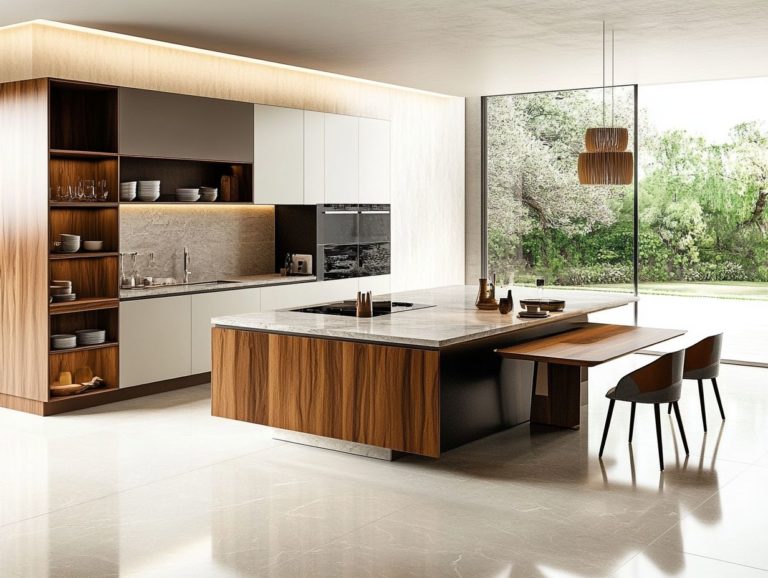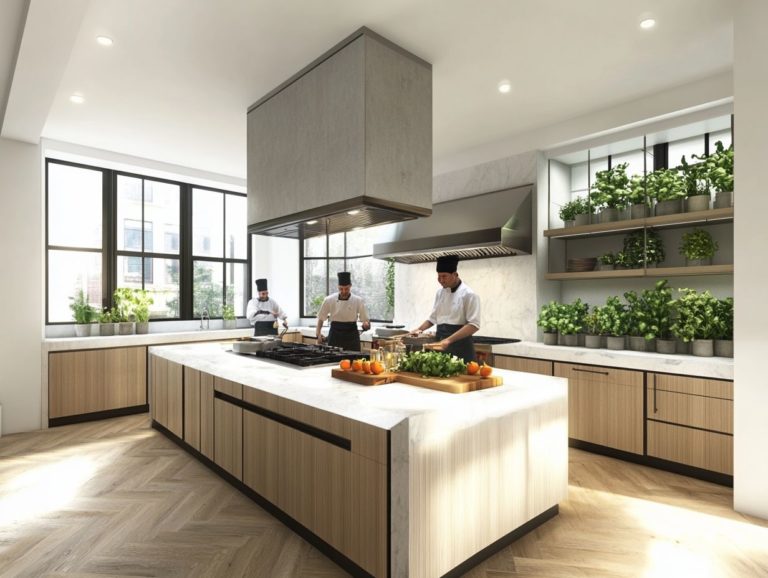5 Smart Layouts for Eco-Friendly Kitchens
Creating an eco-friendly kitchen isn’t merely a passing trend; it’s a lifestyle choice that enriches both your life and the planet.
This article delves into five thoughtfully designed layouts that maximize sustainability while providing practical tips. You’ll discover how to harness natural lighting, select energy-efficient appliances, and choose sustainable materials—all aimed at elevating your kitchen experience.
You’ll receive valuable guidance on avoiding common design pitfalls, exploring budget-friendly options, and implementing long-term maintenance strategies.
Start transforming your kitchen today!
Contents
- Key Takeaways:
- 1. Utilize Natural Lighting
- 2. Incorporate Energy-Efficient Appliances
- 3. Choose Sustainable Materials
- 4. Transform Your Kitchen with Proper Waste Management
- 5. Save Water with Low-Flow Water Fixtures
- How Can an Eco-Friendly Kitchen Benefit the Environment?
- What Are the Key Elements of an Eco-Friendly Kitchen Layout?
- How Can One Incorporate Green Design into Their Kitchen?
- What Are Some Common Mistakes to Avoid When Designing an Eco-Friendly Kitchen?
- What Are Some Budget-Friendly Options for an Eco-Friendly Kitchen?
- How Can One Maintain an Eco-Friendly Kitchen in the Long Run?
- Frequently Asked Questions
- What are the benefits of using eco-friendly layouts in a kitchen?
- What are the key components of an eco-friendly kitchen layout?
- Can you give examples of energy-efficient appliances for an eco-friendly kitchen?
- How can I incorporate sustainable materials in my kitchen layout?
- What are some ways to properly manage waste in an eco-friendly kitchen layout?
- Are there any design tips for maximizing natural lighting and ventilation in an eco-friendly kitchen layout?
Key Takeaways:
- Utilize natural lighting to reduce energy use and improve the overall atmosphere of your kitchen.
- Incorporate energy-efficient appliances to decrease your carbon footprint and save money on utility bills.
- Choose sustainable materials for countertops, flooring, and cabinets to promote eco-friendliness in your kitchen.
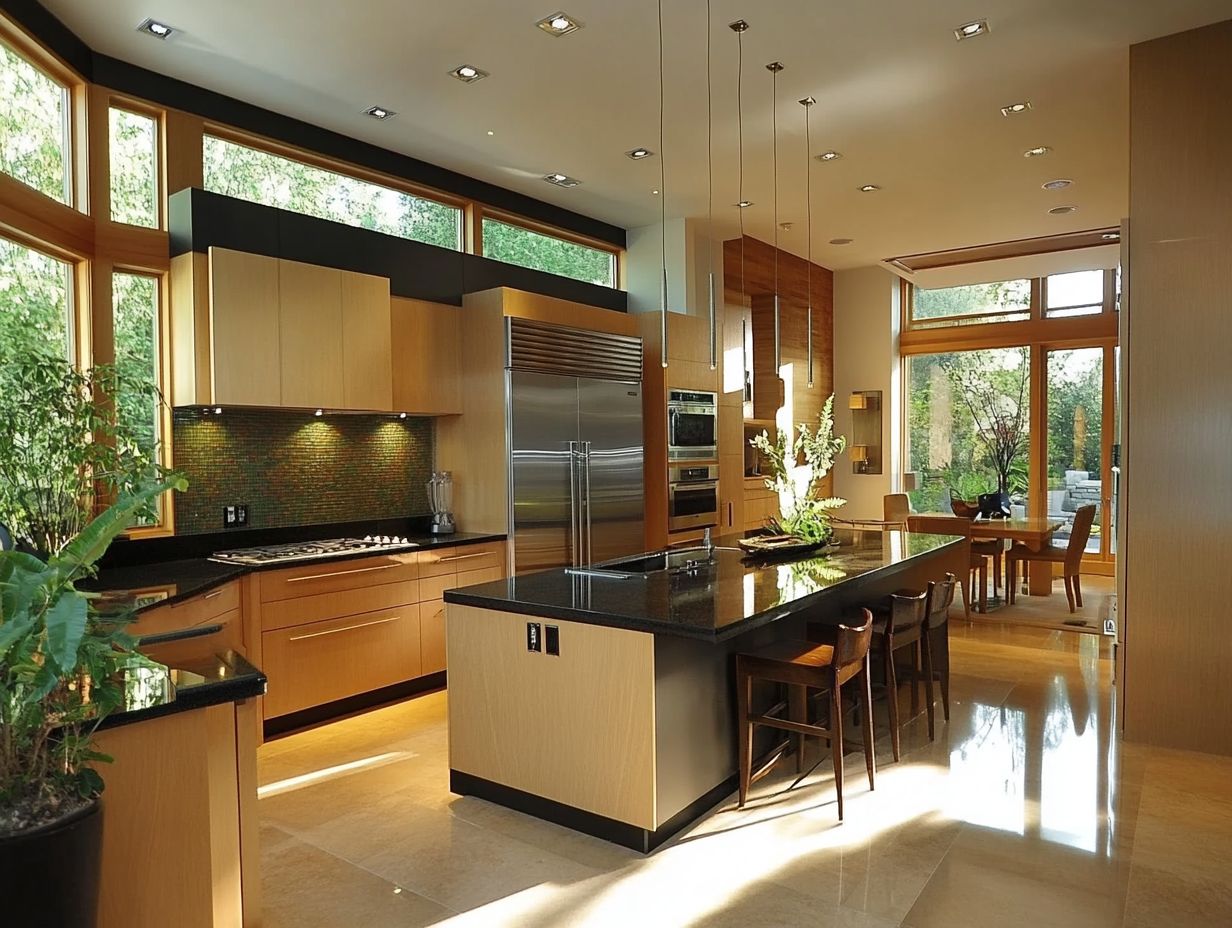
1. Utilize Natural Lighting
Incorporating natural lighting into your kitchen design doesn’t just elevate the space’s aesthetic appeal; it also supports eco-friendly practices.
This thoughtful approach enhances the ambiance. It promotes tranquility and positivity while reducing your reliance on artificial lighting and lowering energy costs.
By strategically placing windows, you can create a welcoming atmosphere. Installing skylights allows sunlight to flood in, brightening even the darkest corners.
Utilizing reflective surfaces, like glossy backsplashes or light-colored cabinets, can amplify the available natural light, significantly brightening the area.
Whether you prefer the sleek lines of contemporary designs or the intricate details of vintage styles, these strategies can be seamlessly integrated to cultivate a warm and inviting cooking environment.
2. Incorporate Energy-Efficient Appliances
Incorporating energy-efficient appliances in your kitchen not only reduces your carbon footprint; it also elevates the functionality and aesthetics of the space.
Imagine features like instant boiling water taps and LED lights that perfectly embody modern and eco-friendly design.
These appliances are designed to minimize energy consumption while offering exceptional performance, making them essential for environmentally conscious homeowners.
Take the instant boiling water tap, for example. It provides hot water instantly, saving you time and energy.
Switching to LED lighting can drastically reduce your electricity use compared to traditional bulbs, further contributing to a sustainable kitchen environment.
Choosing brands that emphasize energy efficiency helps you lower utility bills while supporting a healthier planet. This makes them a smart investment for anyone looking to elevate their culinary space.
3. Choose Sustainable Materials
Choosing sustainable materials like reclaimed wood, bamboo, and plywood is vital for creating an eco-friendly kitchen that captivates the eye and minimizes environmental impact.
By opting for these materials, you can enjoy the inherent beauty and unique character they bring to your kitchen space.
Bamboo, celebrated for its rapid growth and impressive strength, offers a sleek, modern aesthetic while boasting remarkable durability. It resists scratches and moisture better than many traditional options.
Meanwhile, reclaimed wood—with its rich history and rustic charm—infuses warmth and texture, seamlessly complementing both contemporary and vintage kitchen styles.
These choices not only elevate the visual appeal of your space but also champion resource conservation, allowing you to enjoy a stunning kitchen while caring for the planet.
4. Transform Your Kitchen with Proper Waste Management
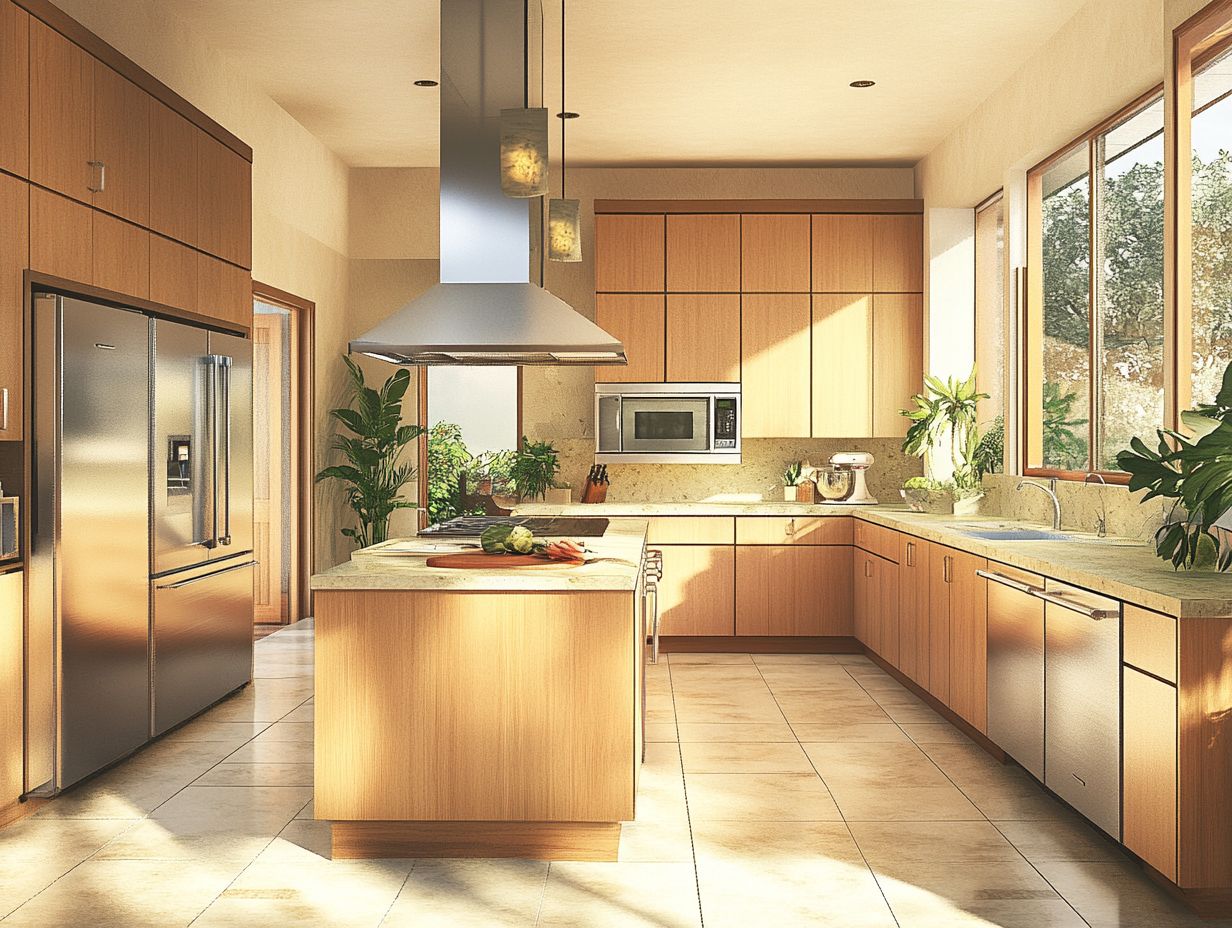
Transform your kitchen into an eco-friendly haven by implementing effective waste management systems. This crucial step ensures your renovation contributes meaningfully to carbon neutrality through smart recycling and composting practices.
By adding these strategies, you can reduce waste sent to landfills while promoting a system where resources are reused and recycled. One vital aspect is sorting waste correctly. When you separate organic materials from recyclables, it minimizes contamination and enables more efficient processing.
Get excited about adding designated bins for compostables, recyclables, and general waste into your kitchen layout. This thoughtful planning not only streamlines disposal but also encourages everyone in your household to engage in sustainable practices.
Ultimately, adopting such systems elevates your kitchen design while significantly enhancing your overall sustainability efforts.
5. Save Water with Low-Flow Water Fixtures
Integrating low-flow water fixtures into your kitchen design is an effective way to save water without compromising performance. This makes it an essential element of any sustainable and eco-friendly kitchen renovation.
These fixtures are crafted to significantly reduce water consumption, often using at least 20% less water than traditional models. By choosing low-flow faucets and aerators, you not only lower your utility bills but also take part in a broader initiative to preserve precious water resources.
Popular options like sensor-operated faucets and dual-flush toilets show how modern technology can enhance functionality while fostering environmental responsibility. These fixtures play a crucial role in boosting the overall sustainability of contemporary kitchen designs, blending efficiency with style to create an environmentally friendly cooking space.
How Can an Eco-Friendly Kitchen Benefit the Environment?
An eco-friendly kitchen does more than elevate your home’s beauty and functionality; it champions sustainability and carbon neutrality. By minimizing resource consumption and waste generation, you’re making a positive contribution to the environment.
Incorporating energy-efficient appliances allows you to significantly cut down on energy usage, which translates to lower utility bills and a reduced carbon footprint. Opting for sustainable materials, like bamboo countertops or recycled glass backsplashes, preserves natural resources while enhancing your kitchen’s durability and appeal.
Embracing practices like composting and recycling fosters responsible waste management. This participation in a collective effort for environmental preservation benefits not just your household, but also inspires a broader movement toward sustainable living, ultimately making a positive impact on local ecosystems and future generations.
What Are the Key Elements of an Eco-Friendly Kitchen Layout?
The key elements of an eco-friendly kitchen layout focus on maximizing space, using sustainable materials, and integrating energy-efficient appliances. These factors cultivate a healthier living environment while significantly reducing your ecological impact.
Thoughtfully organizing your kitchen’s layout enhances workflow and minimizes waste, ensuring that every square foot serves a purpose without feeling cramped. Choosing materials like reclaimed wood or bamboo adds warmth and character to the space, all while lowering the carbon footprint typically associated with new products.
Opting for appliances with high energy ratings dramatically lowers your energy consumption, aligning perfectly with both economic and environmental goals. Incorporating natural lighting and ventilation brightens your kitchen while improving indoor air quality, merging aesthetic appeal with practicality for a genuinely sustainable cooking environment.
Start your journey toward an eco-friendly kitchen today by implementing these essential tips!
How Can One Incorporate Green Design into Their Kitchen?
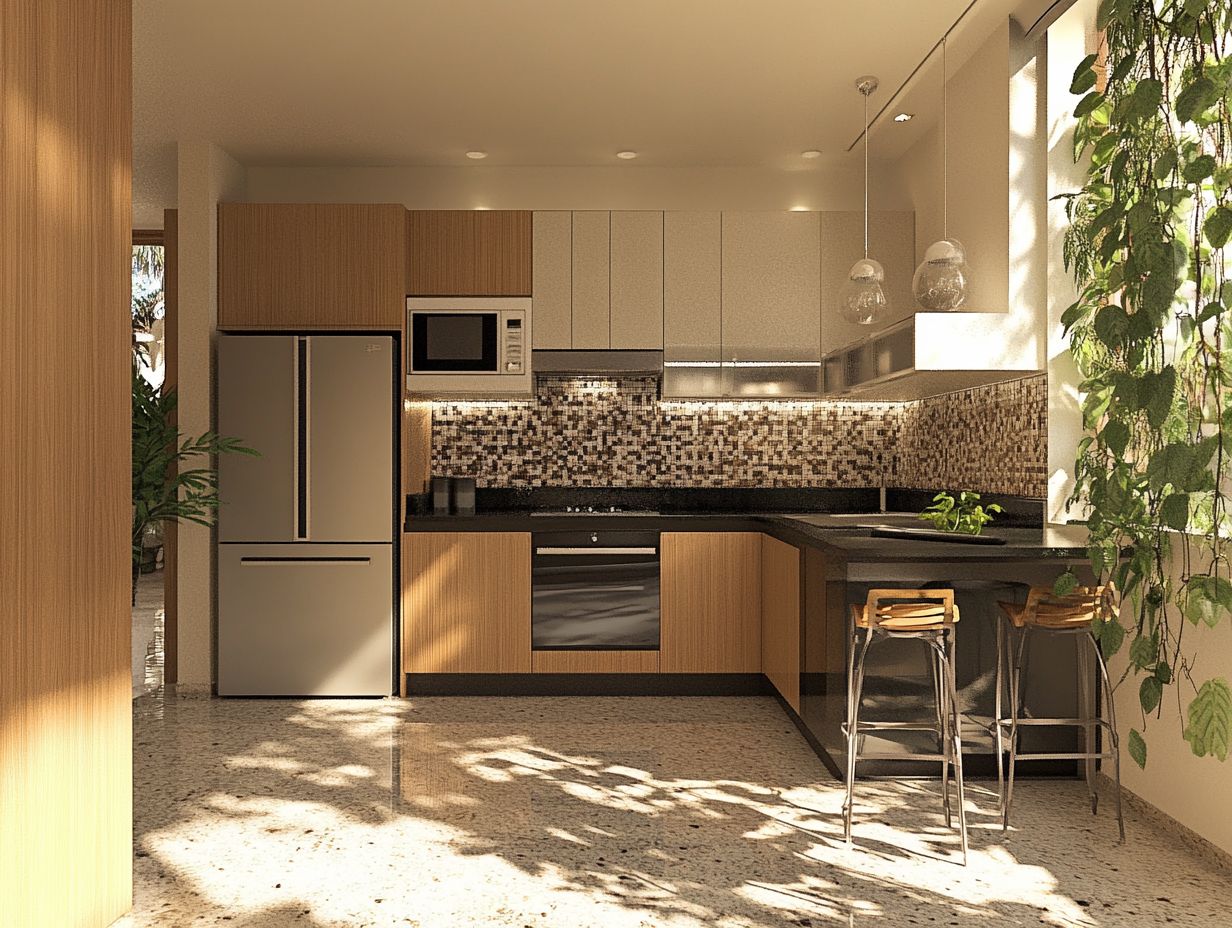
Incorporating green design in your kitchen means carefully selecting eco-friendly materials, energy-efficient appliances, and sustainable practices. This combination creates a space that is both visually appealing and environmentally responsible.
Start by choosing sustainable materials such as bamboo, reclaimed wood, or recycled metal.
This choice reduces your kitchen’s carbon footprint and adds a unique character that tells a story.
When it comes to appliances, opting for Energy Star-rated options ensures minimal energy consumption without compromising performance.
Don’t overlook waste reduction techniques, such as composting food scraps and using recycling bins. These simple practices can greatly reduce your contributions to landfills.
For inspiration, look at stunning designs of eco-friendly kitchens featuring countertops made from recycled materials and LED lights that enhance the ambiance while conserving energy.
These innovations beautifully illustrate how functionality and sustainability can coexist seamlessly in your kitchen.
What Are Some Common Mistakes to Avoid When Designing an Eco-Friendly Kitchen?
When designing an eco-friendly kitchen, it’s crucial to avoid common pitfalls. Neglecting energy-efficient appliances, overlooking sustainable material options, or failing to implement effective waste management systems can undermine your sustainability goals.
Consider integrating natural lighting. This reduces your dependence on artificial light and helps lower energy consumption.
Ignoring proper ventilation can also be a mistake. It hampers energy efficiency and can lead to poor air quality, which is the last thing you want in your culinary space.
Choosing low-VOC paints and finishes is essential for creating a healthier environment. Many conventional products emit harmful gases over time.
By making well-informed decisions and prioritizing sustainability, you can design a kitchen that truly reflects eco-friendly principles, ensuring every detail contributes positively to the planet’s well-being.
What Are Some Budget-Friendly Options for an Eco-Friendly Kitchen?
Creating an eco-friendly kitchen doesn’t have to drain your wallet. There are plenty of budget-friendly options that can help you achieve a sustainable yet stylish space without overspending.
To kick things off, consider exploring reclaimed materials for your countertops and cabinets. They often come with a unique charm that adds personality to your kitchen.
Engaging in DIY projects not only sparks your creativity but also saves you a significant amount of money. This allows you to craft a space that perfectly reflects your vision.
Another key aspect to keep in mind is investing in energy-efficient appliances. While they may come with a higher upfront cost, the savings on your utility bills over time can significantly offset that initial investment.
And don’t overlook local resources like Habitat ReStore, where you can discover gently used items and materials. This contributes to sustainability and helps keep your renovation within budget.
How Can One Maintain an Eco-Friendly Kitchen in the Long Run?
Maintaining an eco-friendly kitchen requires your unwavering commitment to sustainable practices.
This includes updating energy-efficient appliances and developing effective waste management strategies, ensuring the upkeep of sustainable materials—transforming your kitchen into a true model of environmental responsibility.
Regular maintenance is key to achieving this. Regularly assessing your appliances’ performance allows you to spot inefficiencies that may develop over time, enabling timely repairs or replacements.
Waste management goes beyond recycling. Adding composting for organic waste can significantly cut down your landfill contributions. It’s equally important to monitor the condition of eco-friendly materials, such as bamboo or recycled countertops—routine cleaning and care will extend their lifespan significantly.
Simple practices, like making sure your refrigerator is always stocked without overloading it, can enhance energy efficiency and make a substantial difference in maintaining an eco-conscious kitchen.
Frequently Asked Questions
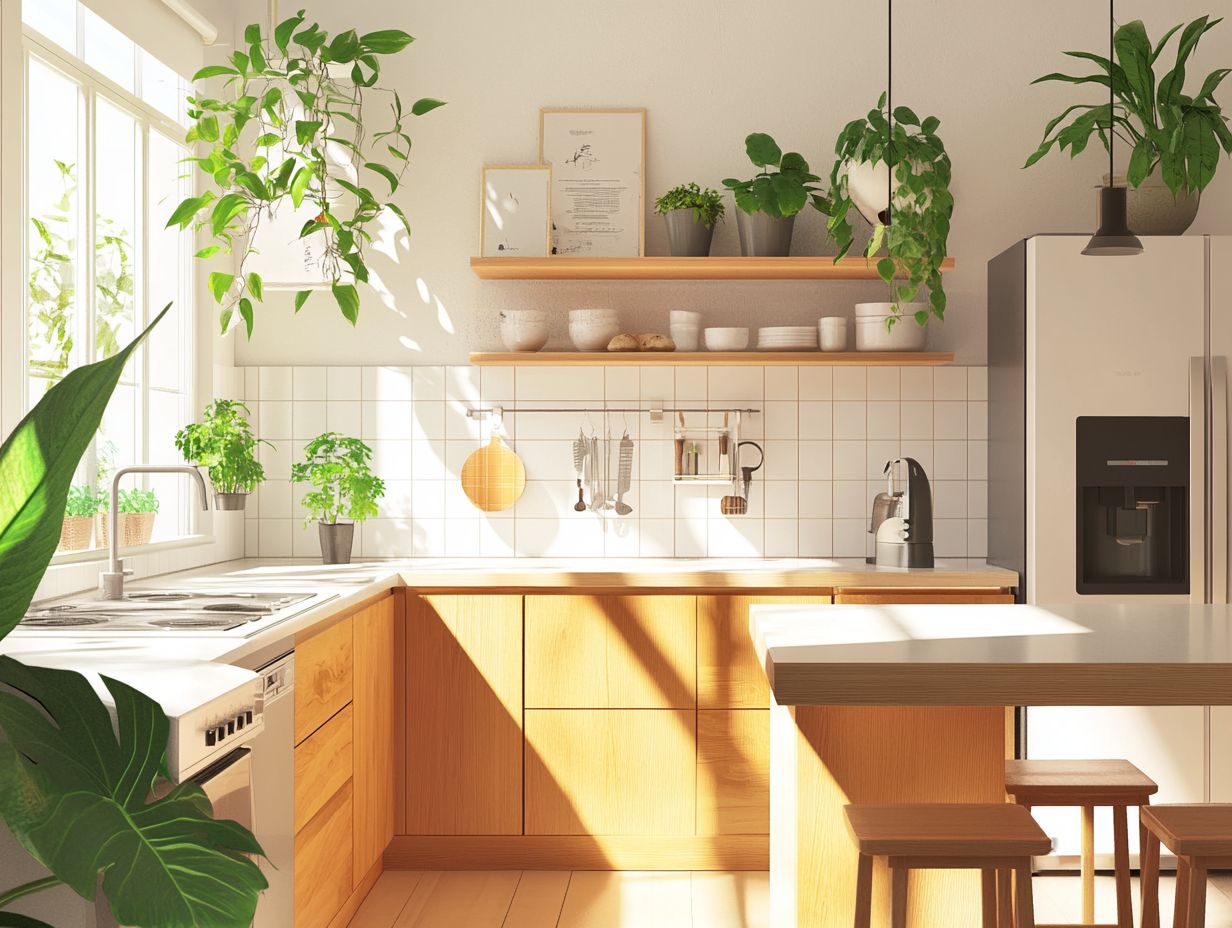
What are the benefits of using eco-friendly layouts in a kitchen?
Eco-friendly layouts help reduce your carbon footprint, lower energy consumption, and promote sustainable living. They also contribute to healthier indoor air quality and save you money in the long run.
What are the key components of an eco-friendly kitchen layout?
The key components are energy-efficient appliances, sustainable materials, proper waste management, natural lighting, and good ventilation.
Can you give examples of energy-efficient appliances for an eco-friendly kitchen?
Some examples include Energy Star certified refrigerators, dishwashers, and stoves, as well as induction cooktops, LED light fixtures, and low-flow faucets.
How can I incorporate sustainable materials in my kitchen layout?
You can use bamboo or reclaimed wood for flooring and cabinets, recycled glass for countertops, and low VOC paints (paints that emit fewer volatile organic compounds, making them safer for indoor air quality) for the walls. Also, consider using eco-friendly materials like cork or linoleum for flooring and cabinets.
What are some ways to properly manage waste in an eco-friendly kitchen layout?
You can install a compost bin for food waste, a recycling center for paper, plastic, and glass, and a separate bin for non-recyclable items. You can also opt for reusable containers and bags instead of single-use ones.
Are there any design tips for maximizing natural lighting and ventilation in an eco-friendly kitchen layout?
Yes, you can install larger windows or skylights to bring in more natural light and use light-colored curtains or blinds to allow more light to enter. For ventilation, consider using a range hood or installing ceiling fans to circulate air. You can also strategically place plants to help purify the air.
